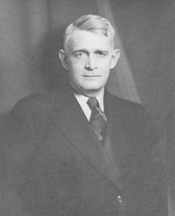Tom Stewart (politician)
Tom Stewart | |
|---|---|
 Photo credited to the United States Senate Historical Office | |
| United States Senator from Tennessee | |
| In office November 9, 1938[1] – January 3, 1949 | |
| Preceded by | George L. Berry |
| Succeeded by | Estes Kefauver |
| Personal details | |
| Born | January 11, 1892 Dunlap, Tennessee, U.S. |
| Died | October 10, 1972 (aged 80) Nashville, Tennessee, U.S. |
| Political party | Democratic |
Arthur Thomas Stewart (January 11, 1892 – October 10, 1972) was a Democratic United States Senator from Tennessee from 1938 to 1949.
Early life and education
Stewart was born in Dunlap, Tennessee. Stewart also had a sister called Lydia. He attended the former Pryor Institute, a private school, in Jasper, Tennessee and Emory College (now Emory University). He returned to Tennessee and attended Cumberland University's law school in Lebanon, Tennessee. Upon admission to the bar in 1913, he set up practice in Birmingham, Alabama. He moved back to Jasper, Tennessee in 1915 and practised there until 1919, then moved to Winchester, Tennessee.
Legal career
In private practice in Winchester, he was elected
Political career
In 1938 Stewart entered the race for the balance of the unexpired term of the late Senator
Stewart was somewhat typical of the Democratic Party's
Stewart returned to the private practice of law. He died in Nashville and was interred at Winchester's Memorial Park Cemetery.
References
- ^ Although eligible and elected, he did not "take his seat" as he preferred to remain as district attorney general. Nevertheless, his service in the Senate begins on the date of election and eligibility, not on the date of an oath.
- OCLC 607061280. Retrieved 2019-01-08.
- ^ "Japanese Internment - PLEA MADE FOR "LOYAL" ALIENS - 1942". www.sfmuseum.org. Retrieved 2019-01-08.

